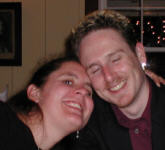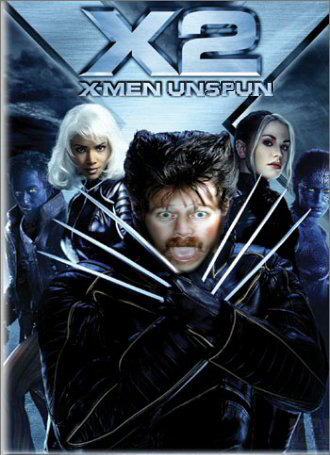For books and films, I have a full record of the ones I’ve read and seen in my Quick Reviews. For music, I have the date on which I ripped an album to MP3. For games, however, I have no such information. Which means I don’t remember if it was 2002 when I first played Ratchet and Clank, or 2003. This means my wrap-up of the games I played last year is going to be shorter and spottier than the others. Probably a good thing.
The first thing to note about 2003 is that, for me, it was a year of console games rather than PC games. I bought a copy of Everquest at the start of the year, played it for a little bit, and came away very disappointed. I suspect that’s partly because I don’t have the patience (and time) to spend weeks building up a decent character and roaming the landscape looking for quests. I like a game that gives me entertaining action right from the start, and I like a story with some decent structure. I also found the graphics to be poor, and hence distracting. I had been hoping to reclaim some of the magic of old-style text MUDs, but it just wasn’t there for me. YMMV, of course.
And that’s it as far as PC games were concerned. I upgraded my PC in the middle of the year (nForce 2 motherboard, Athlon 2500+, Radeon 9600 Pro, 1GB RAM, thank you for asking) in anticipation of goodies like Half-Life 2, Halo, Deus Ex 2, et al. But what do we get? Sod all, and rubbish, respectively.
I downloaded the Halo demo as soon as it came out, and found it to be slow, slow, slow. I’m running nearly top-end hardware, damn it. Even in 800 x 600 mode with graphical detail turned down low, the Halo demo regularly dropped down to 10-15 frames per second on the Silent Cartographer mission. Not acceptable.
Likewise Deus Ex 2. What’s with this 10 frames per second crap? I had to drop down to 640 x 480 resolution and download a tweaked settings file just to get above 20 fps occasionally. And yes, I do have the latest drivers for my video card. Quake III and Unreal Tournament 2003 time demos give me results that are comparable to other people with similar hardware. In addition to immediate action and good story, you can add the following to my list of gaming requirements: fluid graphics.
Smooth movement is key to keeping me immersed in a game, and that’s what I really want. I want to be sucked in and held tight. Graphics are to games what verisimilitude is to a novel. Verisimilitude means that the details you put in have to seem realistic, not necessarily be realistic. If an author can just make me believe that they know exactly how to run a police incident room during a major murder investigation, that’s much more important than rolling out lists of minute details to show off all the painstaking research they’ve done. In games, characters that are animated smoothly to gloss over the cracks in their polygon models beat the pants off lovingly bump-mapped environments that linger on screen like a slowed-down zoetrope.
In PC games, slowdown is only acceptable because of video card envy and hardware snobbery. If a game runs like shit, it must be because you haven’t spent enough money on the latest kit. Well, bollocks to that. This has got to be the only industry where you get less performance and quality the more money you pump into into your equipment. Want to play Halo? Buy a £100 off-the-shelf XBox instead of a £500 off-the-shelf Dell. Hello?? McFly??
And yes, I know that PCs are designed to be much more than just game-playing machines, while consoles are specifically designed to run them. That’s precisely my point. I can play DVDs on my PC, too, but you don’t see Abi and me cuddling up in front of my monitor with a bowl of popcorn on a Friday evening. PC gaming is dead; it just hasn’t stopped kicking yet.
(Phew. That was more of a rant than I’d intended. Maybe I’m just bitter about Half-Life 2 being delayed.)
So anyway, what console games did I enjoy playing in 2003?
- Ratchet and Clank was excellent. It’s one of the very few games I’ve played through from start to finish more than once. It’s well balanced, with good challenges, and it has a goofball sense of humour. It’s fun.
- Ratchet and Clank 2: Locked and Loaded is also excellent. I finished my first run-through of the game about two minutes to midnight on 31st December, so it still counts as a game of last year. It’s basically just more of the same as the original R&C, but that’s a good thing.
- Metroid Prime was marvellous. Lovely environments and lush sound design gave it a sense of atmosphere to rival even something like Myst. The game was tough, but the sense of accomplishment from finishing it was amazing.
- Tiger Woods 2004 got me through October. It has a simple pick-up-and-go game mechanic, a good learning curve, pretty golf courses, and lots of collectibles. It’s the videogame equivalent of a puppy: willing to love you no matter how little you really care for it in return.
- Jak II: Renegade was notable in a “I’m not going to let this $*$%&!! game beat me!” kind of way. The designers took some risks in changing the gameplay so much after the original Jak and Daxter. Some of them paid off, some didn’t. It’s an interesting and entertaining game for the most part; but in places it’s almost impossibly difficult and annoying.
Games that didn’t really make the top tier:
- SSX 3 dropped a lot of the fun characterisation that SSX Tricky had. Also, being good at SSX Tricky means you’ll be pretty good at SSX 3, too, and so it’s less of a challenge.
- Super Mario Sunshine was pretty but unexciting.
- Grant Theft Auto: Vice City hit the 80s nostalgia button, but didn’t inspire me enough to finish it.
- Pikmin was a fun little puzzler.
- Legend of Zelda: The Wind Waker provided some soothing sailing action.
- Frequency was different and fun, for a while.
- Star Wars: Rogue Leader was likewise entertaining, but not very long-lived.
Games I didn’t care for at all:
- Super Monkey Ball 2 suffered a rapid and catastrophic slide from harmless fun into downright annoying.
- Maximo didn’t measure up to the quality of Ratchet and Clank, and frustrated me with its lack of camera control.
- Herdy Gerdy was washed out and drab.
Despite everything I said earlier in this posting, I’m still looking forward to Half-Life 2 for the PC in 2004, but I wouldn’t be surprised if this turns out to be the last PC game I ever buy for myself. On the console front I’m looking forward enormously to Baldur’s Gate: Dark Alliance 2, which should be shipping soon. Halo 2 might tempt me into buying an XBox. Also, there are still a few must-play games from 2003 I still need to catch up on, such as Beyond Good And Evil, Prince Of Persia, and Viewtiful Joe. I’m planning to start writing Quick Reviews for videogames, too, so with any luck next year’s wrap-up will be a bit more coherent…
 I started with a smoked haddock and spinach quiche, with a roast scallop, and lemon dressing. My main course was fish again: fillet of brill, with crab mashed potatoes, a shrimp and scallop fishcake, and shellfish sauce. For dessert Abi and I both had the dark chocolate soufflé with apricot sorbet. The horse’s head emblem in the plate is actually a stencilled dusting of cocoa–a lovely little touch.
I started with a smoked haddock and spinach quiche, with a roast scallop, and lemon dressing. My main course was fish again: fillet of brill, with crab mashed potatoes, a shrimp and scallop fishcake, and shellfish sauce. For dessert Abi and I both had the dark chocolate soufflé with apricot sorbet. The horse’s head emblem in the plate is actually a stencilled dusting of cocoa–a lovely little touch. The soufflé reminded us of the other Plumed Horse restaurant, the one in Saratoga, California, where we enjoyed a fabulous meal at the end of 2000. We had dark chocolate soufflé for dessert then, too, with a dark chocolate sauce to go over it. Abi was pregnant with Alex at the time, though not quite as far advanced as she is now. And just as on our trips to the Scottish Plumed Horse, it was a two hour drive away, only then it was from Oakland down into the South Bay. We had Abi’s parents with us then, and Mick and Sarah, who had managed to stash young Thomas somewhere for the evening.
The soufflé reminded us of the other Plumed Horse restaurant, the one in Saratoga, California, where we enjoyed a fabulous meal at the end of 2000. We had dark chocolate soufflé for dessert then, too, with a dark chocolate sauce to go over it. Abi was pregnant with Alex at the time, though not quite as far advanced as she is now. And just as on our trips to the Scottish Plumed Horse, it was a two hour drive away, only then it was from Oakland down into the South Bay. We had Abi’s parents with us then, and Mick and Sarah, who had managed to stash young Thomas somewhere for the evening. As of this afternoon, I’m the happy owner of a new Motorola v525 phone. I haven’t had much time to play with it yet, but the colour screen is nice, the built-in camera is nice, the polyphonic ringtones (with the option to install my own MP3 to play) are nice, the user interface (which I’d been warned was complicated) is nice, the battery life is very nice, and the overall size and feel of the phone in my hand is, well, nice.
As of this afternoon, I’m the happy owner of a new Motorola v525 phone. I haven’t had much time to play with it yet, but the colour screen is nice, the built-in camera is nice, the polyphonic ringtones (with the option to install my own MP3 to play) are nice, the user interface (which I’d been warned was complicated) is nice, the battery life is very nice, and the overall size and feel of the phone in my hand is, well, nice.